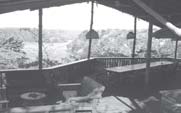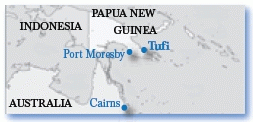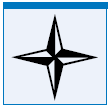Tufi Dive Resort, Papua New GuineaContents of this Issue: Tufi Dive Resort, Papua New Guinea One of PNG’s Last Great Cultural Events Two Other Takes on Protesting a Dive Release Papoo Divers, Nananu-i-ra, Fiji $350 to Fly with a Pony Bottle? Lying About Your Health Could Be Lethal Taking Your Cell Phone Diving: Dumb Idea or Good Safety Tool? Rebuttals About Regulator Servicing Good Technicians Are Going Extinct at Dive Shops How a Diver’s Defense Came Undone Skip the Travel Vest, Just Wear Your BCD Reader Advice for Not Getting Lost at Sea Editorial Office: Ben Davison Publisher and Editor Undercurrent 3020 Bridgeway, Suite 102 Sausalito, CA 94965 everything’s nice - - during the wet season, that is from the January, 2010 issue of Undercurrent
Dear Fellow Diver: “Well, it’s going to be a little bit bumpy today,” divemaster Glenn Kibikibi warned. The trade winds that kept the skies clear, the mosquitoes away, and the evenings balmy at Tufi Dive Resort also blew the sea into white caps when Talio, our 29-foot dive boat, left the shelter of the fjord. Reef trips that would take 20 minutes during the flat-sea wet season were transformed into kidney-jolting rides of 45 minutes in August. The fjord region of Cape Nelson looks like a tropical paradise should. After passing close enough to the mountain tops to see the birds in the trees, the Airlines PNG twin-prop taxied down the grass runway to where a sign announced our arrival at Tufi International Airport. Resort manager Simon Tewson stowed our bags in a Land Rover while assistant manager and occasional chef Matt Brugh walked with us the 100 yards to the resort. Tufi sits high on a ridge overlooking the fjord. Each dawn found me on the deck of my room, writing my log as the rising sun changed the waters from indigo to azure and the forest from evening gray to iridescent green. Each sunset, the clouds atop Mount Trafalgar slowly morphed peach to pink to purple while cackling gangs of red and blue Eclectus parrots swept past.
After an orientation and welcoming fruit drink at the dining deck with brilliant views of the heartbreaking blue water, our gear was trucked down to the dive shop. I set up my tanks, then Glenn and Alex, another divemaster, loaded them on board and stowed our mesh bags under the center bench seat. As captain, Glenn minimized the bouncing, working the swells by alternately gunning and backing down the Honda 225 engine. I had to hang onto the sun canopy strut with one hand and my camera with the other, as there was no rinse bucket. At Stewart’s Reef, we tied off to a channel marker, back-rolled into the 80-degree water and dropped 20 feet down. The table tops and low spires of healthy Acropora corals covered the shallows in pastels. A quick descent to 85 feet and we swam along a slope that dropped below 130 feet before meeting the sea bed. “Jeez, where’s all the fish?” I wondered. No need. As we rounded the bommie, the current picked up and we were into a mini Blue Corner dive. Hundreds of sergeant majors swarmed with blue fusiliers. White-tip reef sharks prowled close to the reef or snoozed on a shelf while gray reef sharks zipped back and forth in the current. Napoleon wrasse hung above, watching me watching them. Reef hooks aren’t used; you have to pick a spot where you won’t back into the coral and fin into the current. After a safety stop poking around the artist’s palette of the bommie top, I handed up my weight belt to Glenn, as he requested, and climbed the wide aluminum ladder. I prefer to put my hands through the straps and let the fins dangle from my wrists when I exit. If I’m on the ladder and the boat bounces me off into the current, I’ve still got fins. After Glenn served our post-dive break of tea, water, and cookies, we headed back into the fjord for our interval. Friendly and gregarious, Glenn explained which clans owned which parts of the area, pointed out hiking trails and told the requisite story of the whale shark that swam into the fjord “just before you got here.” We did the second dive in Tufi Fjord at Hubert’s Point and swam lazily along the slope at 40 feet for almost an hour. Alex found the critters. I counted five species of nudibranch, including an egg-sack-carrying black and yellow notodoris gardineri the size of a tennis ball. Nice, but not what I came for. We docked at the dive shop, and the staff rinsed our gear and hung our wetsuits up to dry. Day two found my gear set up and waiting for me before we bounced out to Bev’s Reef in seas higher than the previous morning. Divemaster Yukio Kumamoto dived in to check the current while Glenn gave a briefing from reef maps. Bev’s is a figure-eight with a saddle that connects the two bommies. Cayman-esque overhangs and promontories are laden with blue sea fans, sponges and whip corals. As soon as we came into the current, the fish appeared. Spotted unicornfish, one brilliant Vlaming’s unicornfish, emperor angels, clown triggers, mobs of butterflies, and gray reef and silvertip sharks. Spanish mackerel run in August, and several big boys zipped by. We zipped by too; the current was stronger and by dive’s end, I was a horizontal flag flapping from the mooring line. Then back to the fjord for a shallow dive at Blue Ribbon Reef but no eponymous eels appeared. Just more healthy coral, lots of anemonefish, cowries, lionfish and deadly cone shells. A Spanish mackerel found its way to our lunch plates along with hand-cut fries and fresh salad, followed by cookies or cake for dessert. By 6 a.m. each day, coffee was served in the lodge along with muffins, toast, fruit and cereal. Pancakes or eggs were available at 7 a.m., leaving plenty of time to hike down the steep hill for the 9 a.m. dive. On the way down, I passed locals on their way up, the heavily tattooed women carrying coconuts, yams and other produce to the market at the top of the hill. Kids arrived via dugout canoes and then hiked up to the school. After the second dive, the Land Rover took us back up to the lodge. Composed of native woods, thatch and a metal roof, the lodge was built from a kit but you wouldn’t know it. High ceilinged, airy and adorned with native artifacts, it houses the office, gift shop, kitchen and dining room but we always ate on the veranda, where lunch and dinner were served at long tables with white tablecloths and fresh flowers. Dinners included killer Cajun calamari, pasta with fresh mushrooms, medallions of pork and, on the last night, Aussie steak with local mud crabs. Desserts like key lime pie, homemade cakes or chocolate mousse left everyone applauding Chef Ephraim Reuben. Soda, beer, spirits and a good selection of Aussie and Kiwi wines were available. Tufi is supplied by local fishermen and farmers, plus a ferry boat whose schedule sometimes slips -- for days. Chilled bottles of boiled water were the sole offering in my room’s mini-fridge. The bungalows have polished timber floors and woven rattan walls. Screened louvered windows with lace curtains let in the breeze while keeping out the bugs. Open-air decks overlooking the fjord or Coral Sea have bilum bag hammocks for lazing away the afternoon. The bathroom was basic with a stall shower, plenty of solar heated water, soap and shampoo. Towels were changed daily. Sheets, every third day. The comfortable queen bed was surrounded with a mosquito net that covered about 90 percent of it. The overhead fan blew a lot of bugs away but it’s PNG -- you will get bitten. I travel with my own pharmacy, including the antibiotic Lomotil, and Malarone as a malaria prophylaxis. Serious ailments have to be treated in Port Moresby, and Airlines PNG flies there to and from Tufi only three times a week. Evenings found us and the other guests -- a Spaniard, a Japanese and two non-diving French journalists -- on the comfy bamboo furniture on the veranda or at the bar. Cocktail hour was presided over by Coco, the resident hornbill who perched on the railing and wrestled with Muji, Simon and Sharon’s dog. Coco will hop over to your chair, ralph up some used papaya -- a friendship offering, I was told -- cock his head to one side, peer at you with wide eyes and wait for a handout. Other menagerie members included Lou the ‘Roo and three caged cus-cus. Then there’s the python under the steps to the lodge, and spiders the size of your hand. Simon, born in PNG and schooled in Australia, regaled everyone with stories of well-meaning government types trying to stop native cultivation of a certain medicinal herb, and about his relations with the local chiefs. The area has seen native strife over the years, with one clan forcefully supplanting another. This makes negotiating the fees for diving rights difficult. As soon as an agreement is made with one clan, another group would say their grandfathers settled the place and they should receive the money instead. Simon’s good negotiating allows Tufi to offer overnight village stays, hikes, the dress rehearsal of a sing-sing, or an eerie trip up a jungle stream to witness the simulated facial tattooing of a local teenage girl. The last day is a non-diving day. You can take a dugout ride to learn how sago palms are turned into food for the locals. Lunch is a barbecue on a pristine snorkeling beach near a village. By my third day, the wind was strong and the morning reef dive was called off in favor of a planned decompression dive to two WWII-era PT boat wrecks. With our aluminum 80’s filled to 3,100 psi, three divers and two divemasters took a short swim from the dock to where the tug-like Raka, Tufi’s largest boat, is moored to one of the wrecks. While my partner and I drifted down to 150 feet, the Spanish chap -- he was on his 13th dive ever -- went Tarzan-like down the mooring, followed by Glenn and Yukio, each carrying a spare tank. By the time we were done poking our lights in the torpedo tubes and headed off through the silt to a wrecked bow section holding a 50- caliber gun, his air was gone and Glenn had handed off one of the spares. Visibility was poor as the bottom is mostly decaying foliage and the accumulated crap from 70 years of Westerners’ presence. Tufi runs a cleanup dive every month but it has a long way to go. Still, when the weather gave me lemons I tried to make lemonade of the muck diving in the fjord. I found ringed and banded pipefish, cuttlefish, a Crocodilus, blue spotted rays, five species of anemone fish, and plenty of nudis like Chelidonura Electra and Thurdilla Splendida. The wind kept us in the fjords for three days. The evening of the fifth day was warm and humid enough to use my room’s AC. Next morning, the seas were calmer so we headed to Paul’s Reef and Marion’s Reef, then an afternoon reef dive at no charge. At Mullaway Reef, I hit the fish lottery -- a school of great barracuda, chevron barracuda, mackerel, pyramid butters, titan and ocean triggerfish, schooling trevallies and, of course, gray reef and white-tip sharks. Having done liveaboards in PNG in the past, would I dive a land-based operation again? If it includes land-based cultural activities and I have limited time, then an emphatic yes. But my best advice whether you’re doing land or liveaboard - - go in the wet season. -- D.L.
|

I want to get all the stories! Tell me how I can become an Undercurrent Online Member and get online access to all the articles of Undercurrent as well as thousands of first hand reports on dive operations world-wide
| Home | Online Members Area | My Account |
Login
|
Join
|
| Travel Index |
Dive Resort & Liveaboard Reviews
|
Featured Reports
|
Recent
Issues
|
Back Issues
|
|
Dive Gear
Index
|
Health/Safety Index
|
Environment & Misc.
Index
|
Seasonal Planner
|
Blogs
|
Free Articles
|
Book Picks
|
News
|
|
Special Offers
|
RSS
|
FAQ
|
About Us
|
Contact Us
|
Links
|
3020 Bridgeway, Ste 102, Sausalito, Ca 94965
All rights reserved.

 During the
October-to-March wet
season, the rains
fall at night and the
seas are flat. By the
December holidays, the
resort’s 19 units are
full and you can make
the long runs to the
storied Black Jack
Bomber and Jacob wrecks
“without spilling your
tea,” according to
Simon.
During the
October-to-March wet
season, the rains
fall at night and the
seas are flat. By the
December holidays, the
resort’s 19 units are
full and you can make
the long runs to the
storied Black Jack
Bomber and Jacob wrecks
“without spilling your
tea,” according to
Simon.  But when the wind is up, the seas are too rough even to get to
nearby offshore reefs. On three of my dive days, we
did muck diving in the fjord.
But when the wind is up, the seas are too rough even to get to
nearby offshore reefs. On three of my dive days, we
did muck diving in the fjord. Diver’s Compass: American divers generally get to PNG through
Brisbane or Sydney, then fly to Port Moresby via Air Niugini . . .
When I checked Brisbane flights, round-trip fares were as low as $273
but book early, and don’t book the “Wild Fare” as this is Australian
for “stand-by” . . . I shlepped my own gear to PNG and paid $200
just for the Brisbane–Port Moresby leg so in retrospect, I would have
rented the resort’s wetsuits, Sherwood regs, Seaquest BCs and Suunto
computers . . . Double-room rates are approximately US$130 to $155
per person per night, including meals and airport transfers; of the
19 units, three have double beds and two have singles . . . Tufi is adding a spa with
sauna, massages, and body treatments . . . There’s TV and Internet in the lodge, but no
Nitrox . . . A two-tank boat dive is US$137, including tanks and weights; for every two
prepaid boat dives, you get to take one free wharf dive before 5 p.m . . . Web site:
Diver’s Compass: American divers generally get to PNG through
Brisbane or Sydney, then fly to Port Moresby via Air Niugini . . .
When I checked Brisbane flights, round-trip fares were as low as $273
but book early, and don’t book the “Wild Fare” as this is Australian
for “stand-by” . . . I shlepped my own gear to PNG and paid $200
just for the Brisbane–Port Moresby leg so in retrospect, I would have
rented the resort’s wetsuits, Sherwood regs, Seaquest BCs and Suunto
computers . . . Double-room rates are approximately US$130 to $155
per person per night, including meals and airport transfers; of the
19 units, three have double beds and two have singles . . . Tufi is adding a spa with
sauna, massages, and body treatments . . . There’s TV and Internet in the lodge, but no
Nitrox . . . A two-tank boat dive is US$137, including tanks and weights; for every two
prepaid boat dives, you get to take one free wharf dive before 5 p.m . . . Web site:
